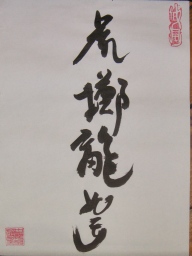Kenmakiryū 剣巻龍 the sword entwining dragon
剣巻龍 Kenmakiryū
Blade engravings, Horimono 彫物, are decorative additions of various designs found on Japanese weapons, most notably swords but including other weapons such as yari, naginata and tantō (there may be a bias in favour of katana due to the historical preservation of heirloom swords and modern academic interest).
These weapon engravings are associated with Shingon Mikkyō, Japanese esoteric Buddhism. The most frequently occurring image is that of the sword wrapping dragon or sword entwining dragon Kenmakiryū 剣巻龍. This image connects warriors (and martial artists) with Fudō Myō-Ō 不動明王 and the goal of attaining Fudōshin 不動心, the immovable spirit.
Fudō Myō-Ō 不動明王, the Immovable Wisdom King – protector of martial artists and yamabushi. Fudō is the personification of Dainichi Nyorai 大日如来 venerated as the central deity of Shingon Mikkyō 真言密教 (true word, secret teachings). Fudō is the most prominent of the five wisdom kings, godai myō-ō 五大明王, bellicose and wrathful beings who frighten people into accepting the true path of Buddha and representing the power of humans to overcome their base passions.
Fudō has a furious countenance, blue skin, wielding a straight, double-edged sword in his right hand and rope or noose in the left. The rope is used to pull people back on to the correct path when they are heading towards evil or binds those that are ruled by violent emotions and passions. If the rope is ineffective then the sword is used to sever the link between worldly afflictions and karma thereby quenching the defiance in a persons heart to return them to the right path.
The sword – a type of hōken 宝剣 treasure-sword – has the dual purpose of being the demon subduing sword to conquer evil spirits and the sword of wisdom that cuts through human delusions and ignorance. The sword itself is of an ancient style, that of the straight ken or tsurugi 剣, brought to Japan in conjunction with Buddhism and Buddhist imagery and maintaining this visual form to the present day. The form of this sword is an extension of the main symbol of Shingon Mikkyō, the Vajra, known as Kongōsho金剛杵 in Japan. The vajra represents a thunderbolt, symbolising irresistible force, and diamond, symbolising indestructible truth. The vajra is used as a weapon to crush resentment and destroy evil. It comes in various forms, including the single pronged dokko 独鈷 and the three-pronged sanko 三鈷, that are incorporated into the hōken image. This straight sword is also seen in association with yamabushi.
There is a legend that Fudō was challenged to duel with a representative of another faith. They both transformed their bodies into various forms to gain advantage, upon assuming the form of flaming swords they found they were equally matched. Fudō then transformed into a dragon, entwining the opponents sword and began to devour it from the tip and achieved victory. This image has been passed down to the modern day as the sword entwining dragon Kurikara Ryū-Ō Fudō 倶梨伽羅龍王不動 or shortened to Kurikara Fudō 倶梨伽羅不動. The dragon is both servant of Fudō as well as being a representation the deity. The sword wielded by Fudō is called Kurikara-ken 倶梨伽羅剣.
The image of the sword and dragon is seen to represent the weapons used by Fudō, the dragon being the rope, used to capture and bind, not to kill. You can seen here the rule in Gyokko ryū to use only the force that is necessary to achieve victory. The sword is the last resort and you must not rush to use it. Use the technique or weapon that is appropriate.
The aim of the warrior is to posses Fudōshin, the spirit of Fudō. Fudōshin can be understood as many things – having a magnanimous and compassionate heart that remains dauntless – to possess unwavering resoluteness – to be a point of calm in a tempest – to be steadfast, immovable, imperturbable. By carrying an image of kenmakiryū on ones weapons the warrior is invoking the protection of Fudō and expressing the aspiration to achieve Fudōshin. Fudō serves humankind in protecting it from itself, the same should be true of the martial artist in protecting others.
The martial artist is not expressing the idea of non-violence. The martial artist will fight when required for the purpose of protecting others. The difference between selfish power and just action. The martial artist does not seek violence but will respond appropriately to the violence of others with a calm heart.
This can be seen as the calming of emotional responses or extremes. Fudōshin is to be able to control emotions, removing the ego enabling the body, mind and spirit to act in unison, unencumbered by desires – as seen in the idea of mushin 無心, no-mind, a mind that is not distracted as opposed to an empty or vacant mind.












[…] : https://bujinshugyo.wordpress.com/2012/04/18/kenmakiryu-%e5%89%a3%e5%b7%bb%e9%be%8d-the-sword-entwini… Évaluez ceci : J'aimeJ'aime […]